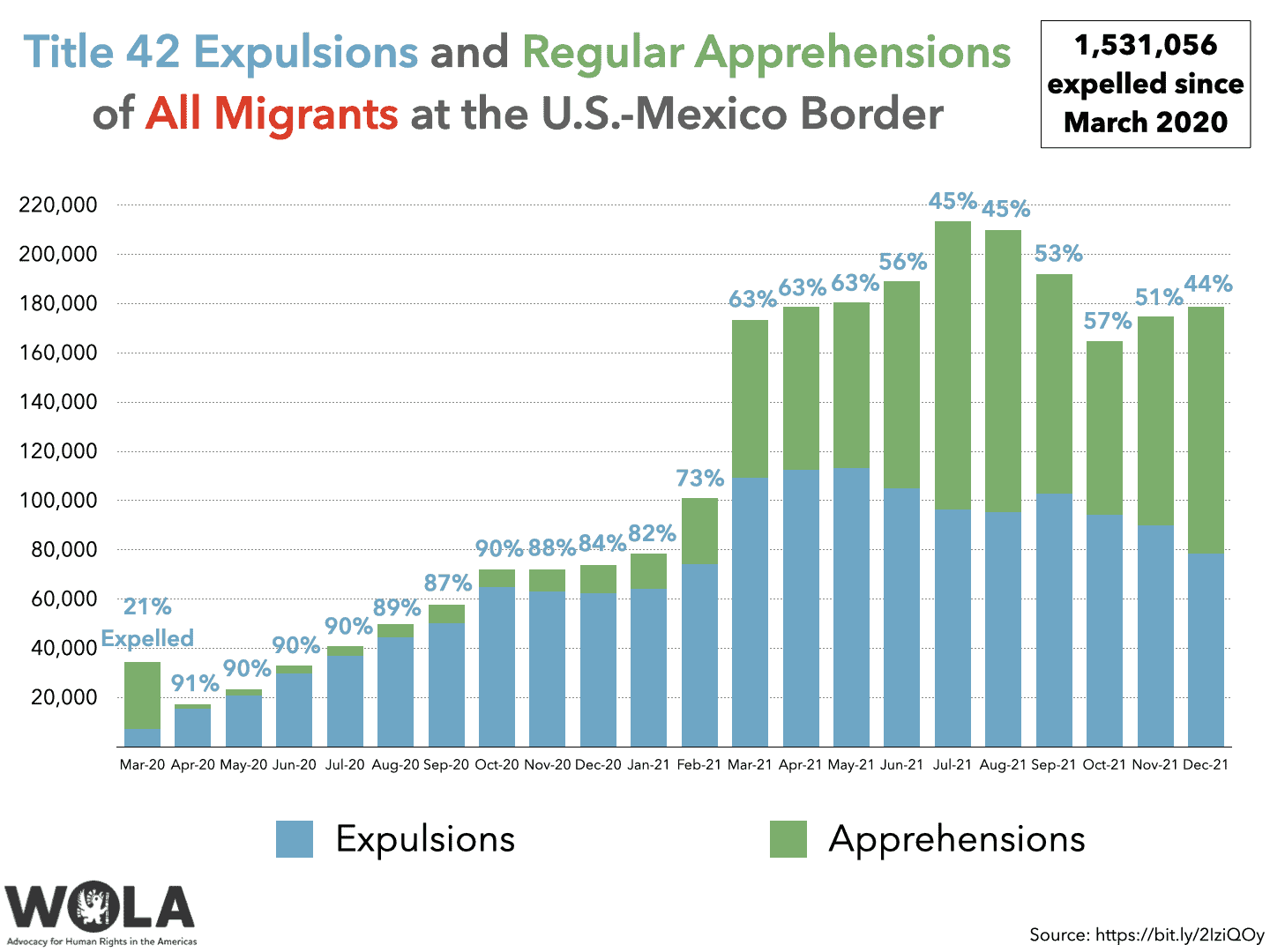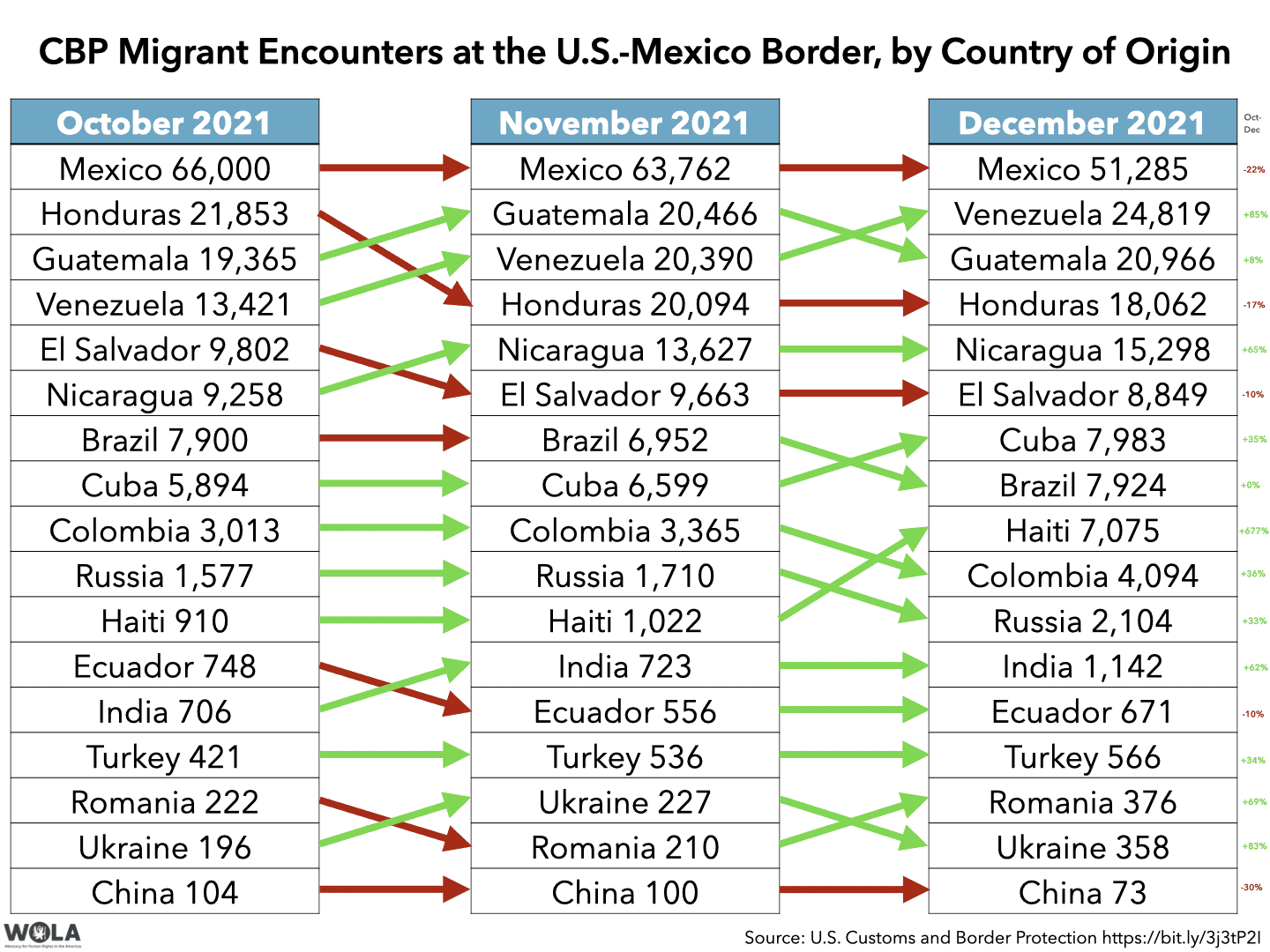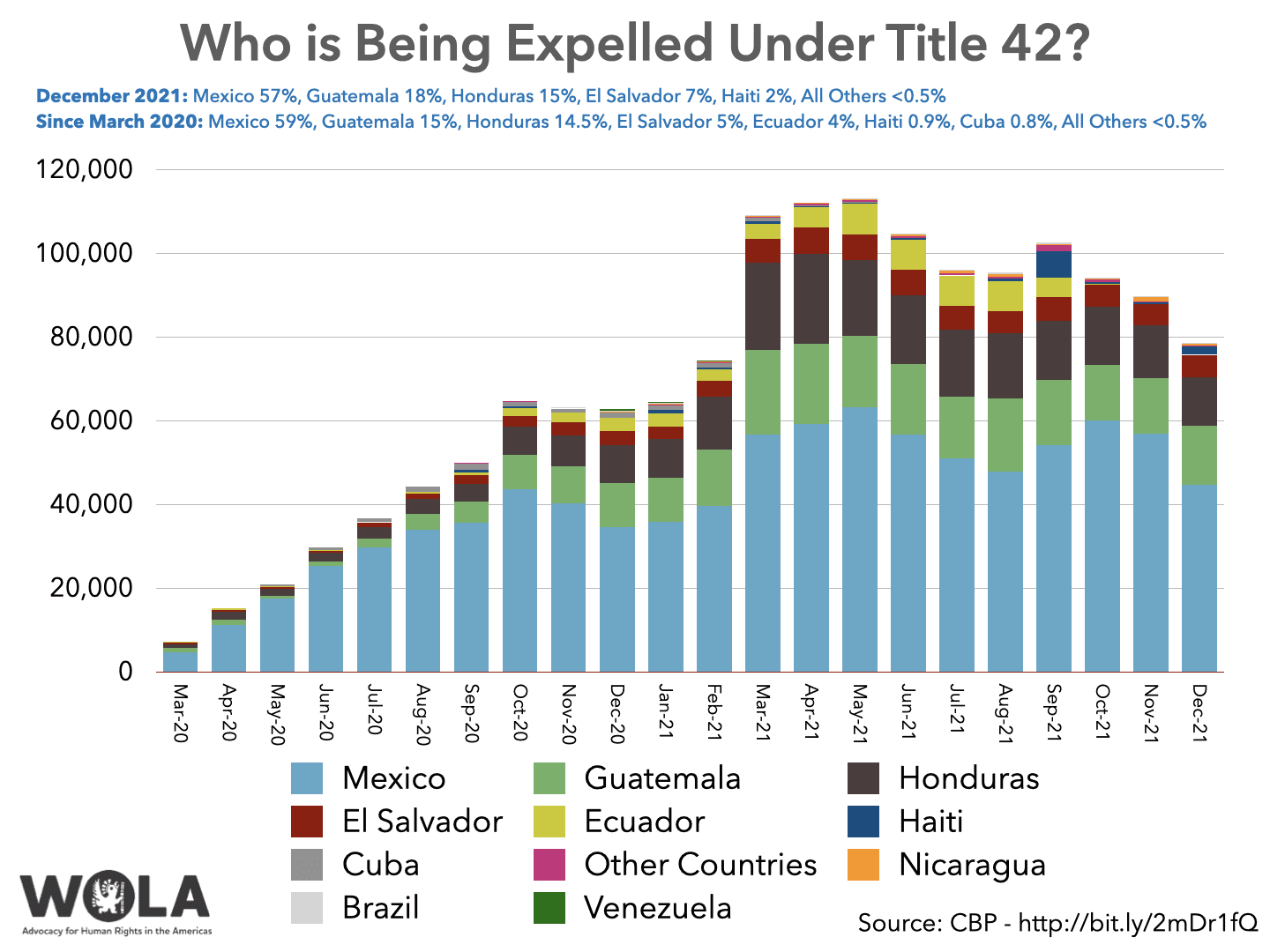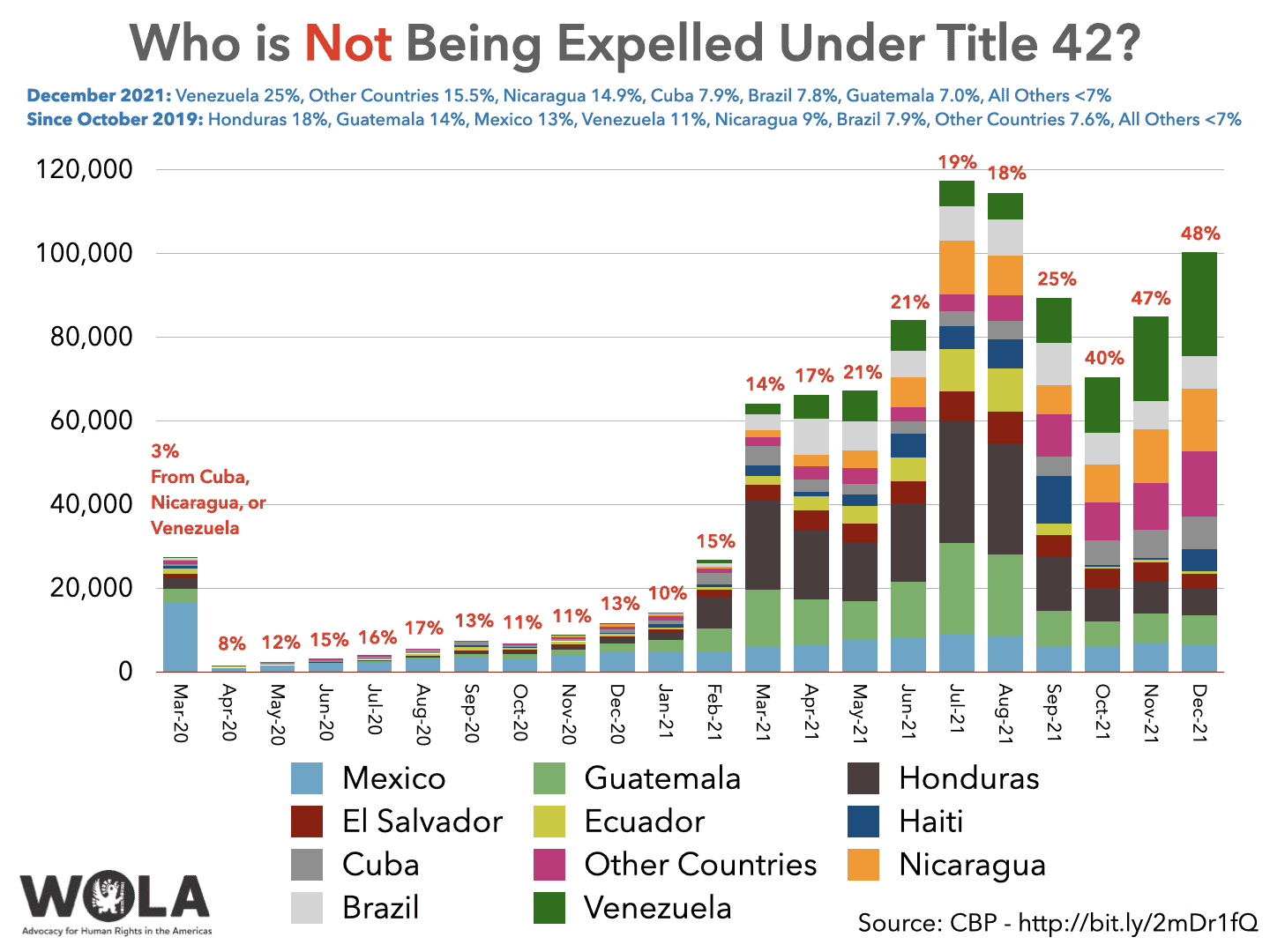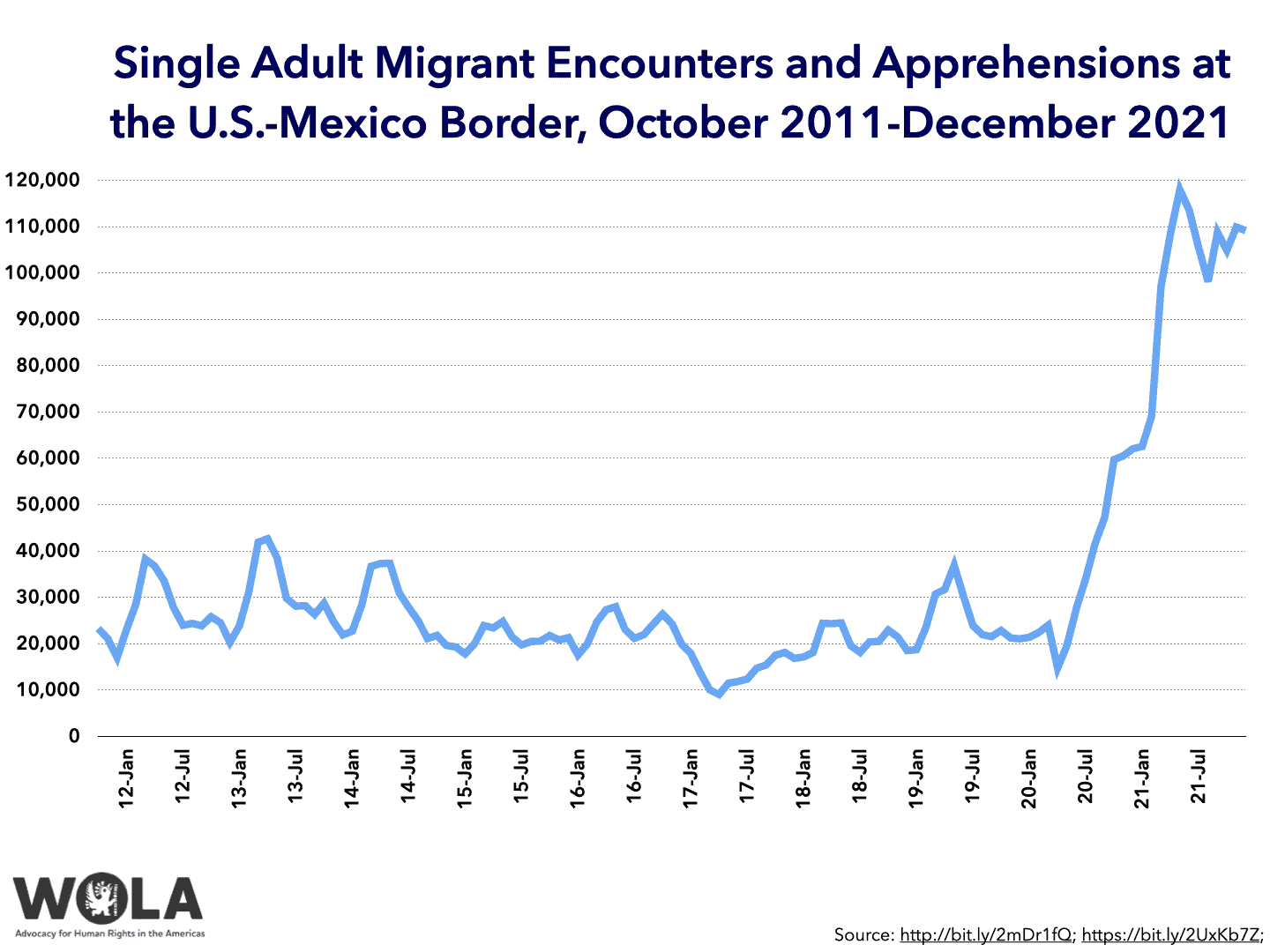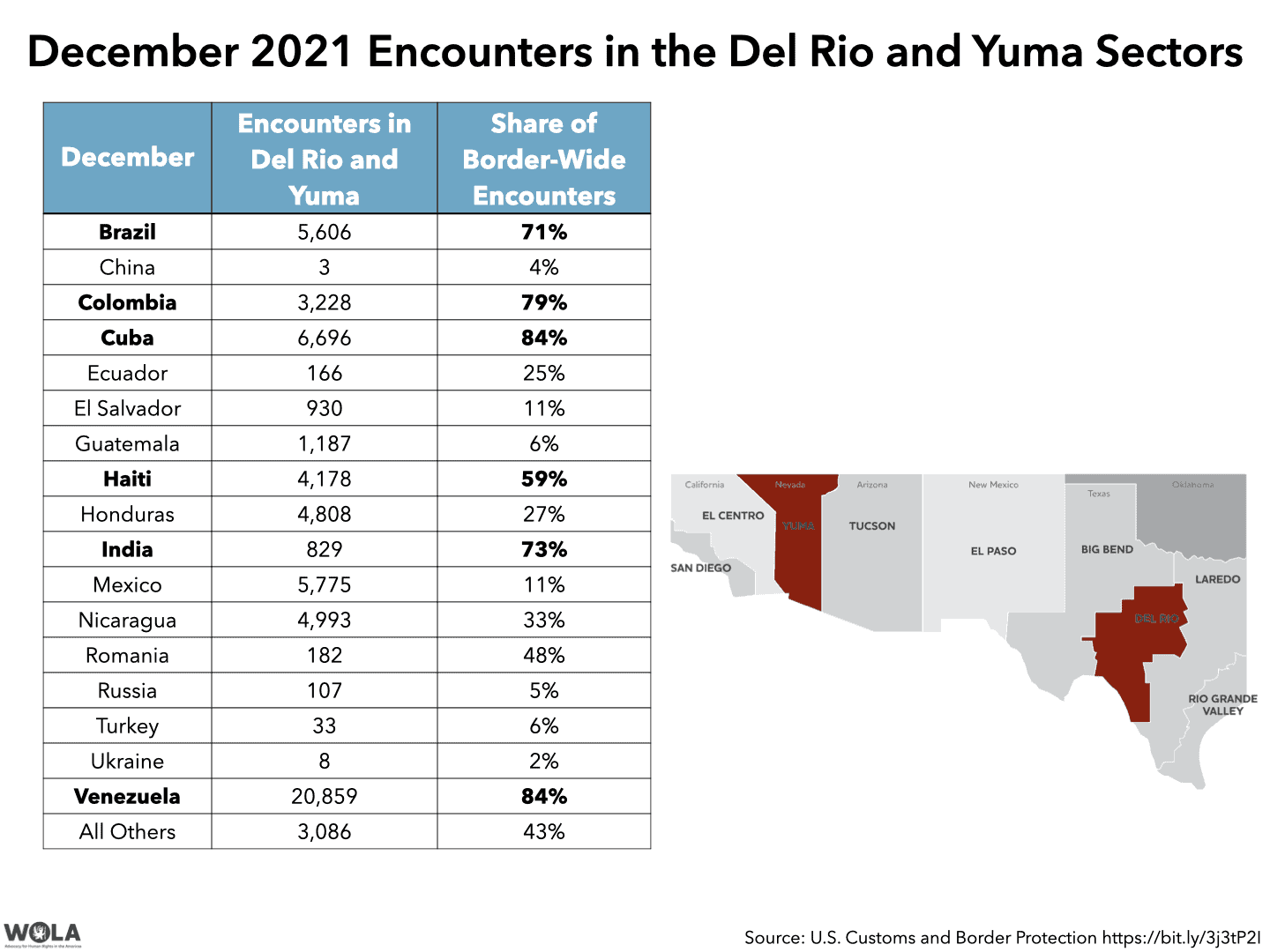With this series of weekly updates, WOLA seeks to cover the most important developments at the U.S.-Mexico border. See past weekly updates here.
December’s migration data
On January 24 U.S. Customs and Border Protection (CBP) released data about its encounters with undocumented migrants at the U.S.-Mexico border during December 2021. The agency took migrants into custody 178,840 times last month, probably the tenth-largest monthly total of this century. CBP’s Border Patrol component, which operates between official land border crossings (ports of entry), encountered 170,186 migrants, and its Office of Field Operations (OFO) encountered 8,654 at the ports of entry.
December’s total was 4,000 more than November—a 2 percent increase, the first month-on-month increase in the overall encounter total since June-July 2021. However, as CBP’s release pointed out, the agency actually encountered fewer migrants per day in December (with 31 days, after all, December is 3 percent longer than November).
As is common since the pandemic began, many of those “encounters” are the same person counted more than one time. The Title 42 policy, which expels many migrants back into Mexico with little time in CBP custody, has eased repeat attempts to enter the United States. The number of individual people whom CBP encountered in December was 135,040. While much lower than “encounters,” that “individuals” total was about 5 percent larger than November’s.
Walking through the numbers, an analysis from Philip Bump at the Washington Post points out that roughly one sixth of “encounters” result in a migrant being allowed to remain in the United States outside of detention while awaiting immigration court proceedings. The other five-sixths are expelled, or detained in Immigration and Customs Enforcement (ICE) custody.
In December CBP passed 1.5 million expulsions of migrants since March 2020, when the Trump administration first implemented Title 42. In many cases, these migrants were asylum seekers denied the chance to petition for protection from threats to their lives. 78,589 of December’s migrant encounters—44 percent—ended in expulsions.
That monthly percentage is the smallest since Title 42 went into effect. “CBP expelled only 44% of individuals under Title 42 in December 2021, again highlighting the Biden administration’s refusal to fully utilize the public health authority,” complained a press release from Republicans on the House of Representatives’ Homeland Security Committee.
44 percent did not represent any slackening in the use of Title 42, however. It instead reflects the nationalities of the migrants encountered in December. Of migrants who avoided expulsion last month, less than a quarter came from Mexico or from the three Central American nations whose citizens Mexico agrees to take back under Title 42 (El Salvador, Guatemala, and Honduras). The other three quarters are from countries to which expulsions are more difficult, either due to the cost of flying migrants back (as has happened to over 19,000 Haitians during the Biden administration), or due to poor diplomatic and consular relations.
Remarkably, 48 percent of December’s non-expelled migrants—47,682—came from Venezuela, Nicaragua, or Cuba. (Venezuela was 2nd overall in migrant encounters last month, after Mexico.) The Biden administration almost never sendsthose migrants on planes back to Havana, Managua, or Caracas. It is, however, sending citizens of those countries to “Remain in Mexico” to await their U.S. asylum hearings under a court-ordered renewal of this Trump-era program, which since December 8 has been undergoing a gradual rollout.
11,921 of December’s encounters were with children who arrived at the border unaccompanied. That was the smallest unaccompanied child total since February 2021, and 14 percent fewer than November. The Biden administration is not expelling unaccompanied children under Title 42.
Members of family units (parents with children) increased 14 percent from November, to 51,926. Remarkably, 7 out of every 10 family members encountered last month (69 percent) came from countries other than Mexico, El Salvador, Guatemala, or Honduras.
After shooting upward when the Trump administration began applying Title 42 in 2020, then peaking during spring of 2021, encounters with single adults have plateaued. They dipped by a few hundred from November to December.
Of the nine sectors into which Border Patrol divides the border, South Texas’s Rio Grande Valley region continued to lead all others in monthly apprehensions, with 43,844, most of them Central American citizens. The number-two and number-three sectors are unusual and surprising: both are sparsely populated zones that saw little migration during the 2010s: Texas’s Del Rio sector (Del Rio and Eagle Pass the largest border towns), and the Yuma sector that straddles Arizona and California (Yuma the largest border town). Arrivals in Yuma during the first quarter of fiscal 2022 are up 2,391 percent over the first quarter of fiscal 2021.
Only 32 percent of migrants in Del Rio, and 7 percent of migrants in Yuma, came from Mexico, El Salvador, Guatemala, or Honduras. These “unusual” sectors have seen high concentrations of migrants from “unusual” countries like Brazil, Colombia, Cuba, Haiti, India, and Venezuela.
This concentration of nationalities along specific geographic sectors seems to owe to fast-evolving smuggling networks, about which we have little information. “It is evident that migrants’ nationalities have concentrated route trajectories and precise points of arrival, unrelated to casual factors. We can say in jest that they share the same ‘travel agency,’” Tonatiuh Guillén, a longtime migration expert who was briefly the López Obrador administration’s first INM director, observed in a recent analysisof this phenomenon.
U.S. border authorities are expecting migrant encounters to rise in the spring of 2022, possibly exceeding 2021 totals. Two officials told Reuters that they “are preparing for as many as 9,000 border arrests per day by the spring”—which would mean record-breaking monthly totals above 270,000 encounters. That, however, is a “worst case scenario,” one of Reuters’s anonymous sources said.
In Mexico, meanwhile, on January 23 the government’s National Migration Institute (INM) reported apprehending more than 3,000 migrants in a 48-hour period, many of them discovered in the backs of cargo trucks. During 2021, a record-breaking year for Mexico, the INM apprehended an average of 690 migrants per day; reaching 1,500 per day over two January days is a strong sign that 2022 will be another year of very heavy migration for the region.
Mayorkas visits Border Patrol, hears griping
Department of Homeland Security (DHS) Secretary Alejandro Mayorkas paid visits on January 26-28 to Border Patrol’s Yuma (Arizona-California), El Paso (Texas-New Mexico), and Laredo (Texas) sectors, where he met with many CBP and Border Patrol line personnel. Mayorkas filled his Twitter account with photos of him aboard Border Patrol boats and ATVs, showing up for early-morning muster, and conferring with sectors’ leadership. The Secretary repeatedly described agents as courageous, dedicated, mission-focused, talented, and impressive, while often calling for “more resources and support” for Border Patrol.
The feeling did not appear to be fully mutual. In Yuma, an agent surreptitiously recorded audio of the Secretary’s discussion with assembled agents and leaked it to TownHall.com, a right-wing website. The recording revealed some tense moments as Mayorkas fielded complaints from a workforce whose union—which claims to represent 90 percent of agents—strongly backed Donald Trump and vociferously criticizes the Biden administration’s policies.
“I know the policies of this administration are not particularly popular with U.S. Customs and Border Protection, but that’s the reality and let’s see what we can do within that framework,” Mayorkas told the agents. Some blamed the Biden administration for the increase in asylum-seeking migrants during 2021 that required agents to care for children and families while processing asylum paperwork, instead of the law enforcement tasks for which they were trained. “I know apprehending families and kids is not what you signed up to do. And now we got a composition that is changing even more with Cubans, Venezuelans, Nicaraguans, and the like, it just gets more difficult,” Mayorkas said. One agent turned his back on Mayorkas after asking an aggrieved question about being forced to process children and families.
Another complained about the slow rollout of the Remain in Mexico program, ordered by a Texas federal district court judge, which to date has been applied to a few hundred migrants. In public, including in a strongly worded October memo“re-terminating” the program, Mayorkas has criticized “Remain in Mexico” and insisted that his department opposes the judicial order to restart it. In private, Mayorkas told the agent, “The numbers are not where they need to be. I agree with that.”
Though the Biden administration halted border wall building and publicly opposes Donald Trump’s use of resources to wall off the border, Mayorkas privately assured agents that “he has approved for gaps in the border wall system, which were created when Biden ordered a halt on construction, to be filled.”
After the audio leaked, DHS spokesperson Marsha Espinosa shared a statement with Reuters indicating that Mayorkas “welcomes candor during these conversations, and appreciates and respects the opinions of each member of the CBP workforce.”
In the Yuma meeting, an agent told the Secretary that “it has been ‘demoralizing’ to see politicians and others ‘demonize’ Border Patrol when they often save illegal immigrants from injury and death.” TownHall.com speculated—probably correctly—that this was a reference to an incident in Del Rio, Texas, in mid-September 2021. After video showed Border Patrol agents on horseback charging at Haitian migrants in an attempt to keep them from crossing the Rio Grande, Mayorkas had said he was “horrified” and President Joe Biden said “those people will pay.” At the time, the Border Patrol union shot back demanding an apology from the President.
“I want to assure you that we are addressing this with tremendous speed and tremendous force,” Mayorkas told the House Homeland Security Committee on September 22, days after the Del Rio incident, vowing that an investigation would “be completed in days—not weeks.” 128 days later, DHS has not made any public determination about what happened in Del Rio.
The DHS Inspector-General declined to take the case, and CBP’s Office of Professional Responsibility shared preliminary findings with the Justice Department in October, to determine if criminal charges were warranted. Other than a list of next steps that DHS published in mid-November, there has been no further word. Now, unnamed DHS officials told the Washington Examiner that “a report may never be released.”
Congress steps up oversight of Border Patrol’s “Critical Incident Teams”
Accountability for alleged Border Patrol abuse came into focus in Congress on January 24, as the Democratic Party chairs of responsible committees launched investigations of secretive teams within the agency whose responsibilities appear to include protecting agents against abuse allegations.
In an October 2021 document, the Southern Border Communities Coalition (SBCC) surfaced the issue of Border Patrol’s “Critical Incident Teams,” which often arrive at the scene when agents may have committed wrongdoing. While Critical Incident Teams may have other roles, coming up with exculpatory evidence to protect agents strongly appears to be one of them. No other law enforcement agency, the SBCC contends, has a similar capability, and the Teams’ existence is not specifically authorized by law.
SBCC was alerted to the Teams’ role while carrying out advocacy around the caseof Anastasio Hernández, a Mexican citizen whom border agents beat and tasered to death in a 2010 case caught on cellphone video. The Coalition found that a Critical Incident Team failed to notify San Diego police, controlled police investigators’ witness lists, tampered with evidence, sought to obtain Hernández’s medical records, failed to preserve video evidence, and “contacted the FBI and asked them to charge Anastasio with assault while he lay brain dead in the hospital. The FBI declined.”
Critical Incident Teams have existed in some form at least since 1987. (Their “challenge coin,” depicted in SBCC’s October document, says “Est. May 21, 2001” and includes images of a chalk outline and a rolled-over vehicle.) They are almost never mentioned in Border Patrol or CBP statements. “Their existence poses a threat to public safety,” SBCC argues, “by concealing agent misconduct, enabling abuse, and exacerbating impunity within the nation’s largest law enforcement agency, U.S. Customs and Border Protection (CBP). Immediate investigations into BPCITs are imperative.”
The Critical Incident Teams came up again in a January 10 front-page New York Times story about Border Patrol vehicle pursuit tactics that have seen a growing number of fatal crashes. Following an August 3 crash in New Mexico, the Times reported:
Body camera footage from a state police officer captured one of the Border Patrol agents saying: “Our critical incident team is coming out. They’ll do all the crime scene stuff—well, not crime scene, but critical incident scene.” The agent said that he and his colleague would give statements to the team, which it would share with the police.
This reporting, and persistent work by the SBCC, moved leading members of Congress to act. A CBP briefing about the teams late last year, the New York Times notes, “did not fully address our questions,” said Rep. Bennie Thompson (D-Mississippi), chairman of the House Homeland Security Committee. Subsequent information requests have gotten no replies from the agency.
The next step came with two letters on January 24:
- Ten chairpeople of House and Senate Judiciary, Homeland Security, and Oversight committees and subcommittees wrote to Comptroller-General Gene Dodaro, who heads the U.S. Government Accountability Office (GAO, the Congress’s auditing and investigative arm). They ask the GAO to produce a report about them: “We would like to better understand the roles and responsibilities of these Critical Incident Teams, including their authorities, activities, training and oversight.” The letter lists nine questions about the Teams’ authorities, procedures, training, budget, and track record.
- The chairs of the House Homeland Security and Oversight Committees, Rep. Thompson and Rep. Carolyn Maloney (D-New York) wrote to CBP Commissioner Chris Magnus, informing him in a more strongly worded message that they are launching their own joint investigation into the Critical Incident Teams. “We have grave concerns about the lack of transparency in the role of Border Patrol’s Critical Incident Teams,” the letter reads. “Despite the apparent lack of authority to investigate agent misconduct, Border Patrol appears to have created special teams of agents to investigate and collect evidence following incidents that may create criminal or civil liability, including allegations of excessive use of force.”
The Thompson-Maloney letter requires that CBP turn over, by February 7, a list of all existing Border Patrol evidence collection teams; a detailed list of the legal authorities under which the Teams operate; all polices, procedures, directives, guidances, and training materials for the Teams; all incident reports filed since 2010; and all reports of “potential misconduct or interference with criminal, civil, or administrative investigations by Border Patrol Critical Incident Teams or team members” since 2010.
Bloomberg Government asked CBP Commissioner Magnus, a former Tucson, Arizona police chief who has been in his position since early December, about the Critical Incident Teams. A statement responded that “U.S. Customs and Border Protection’s specialized teams are ‘vitally important’ in the collection and processing of evidence related to enforcement activities,” Bloomberg reported. “The teams assist CBP’s Office of Professional Responsibility and other law enforcement agencies when they conduct investigations involving agents and work on enforcement cases related to human trafficking and drug smuggling.” Magnus said that CBP would work with the committees and with GAO.
Links
- Vice President Kamala Harris was in Honduras on January 27 for the inauguration of President Xiomara Castro. The Biden administration hopes that Castro will follow through on her declared intention to pursue anti-corruption and other reforms to address “root causes” of migration away from Central America. Presidents of neighboring El Salvador and Guatemala have proved disinclined to pursue such reforms.
- The revived “Remain in Mexico” program has begun operating in Brownsville, Texas, the third of seven ports of entry at which the Biden Administration is expected, under court order, to roll it out. The first three asylum seekers were returned on January 25. Brownsville is across from Matamoros, in Tamaulipas, a notoriously dangerous Mexican state for migrants. Those placed in “Remain in Mexico” in Matamoros will have the option to await their U.S. court dates four hours’ drive from the border in Monterrey, a large, and presumably safer, industrial city in Nuevo León state.
- Lourdes Maldonado, shot in her car on January 24, was the second journalist to be murdered in Tijuana within a week. Concerns about insecurity and organized-crime violence are high in the border city, an active venue for the Remain in Mexico program. More than 2,000 members of the National Guard, Mexico’s new militarized police force, are to be deployed to Tijuana in coming days.
- The U.S. embassy in Mexico tweeted photos of Mexican immigration agents being trained in what appear to be riot-control tactics, with plexiglass shields, in a November course in El Paso funded by the State Department and carried out by CBP.
- The Intercept, the Texas Tribune , and the Houston Chronicle covered the unintended consequences of Texas Governor Greg Abbott’s (R) border crackdown, which has arrested over 10,000 undocumented migrants for trespassing since April 2021. Many who spend time in Texas state jails end up allowed to stay in the United States to pursue their asylum cases, avoiding Title 42 expulsion. Now, an Austin judge’s ruling on the constitutionality of the governor’s plan could bring it to an end.
- Arizona has deployed about 220 National Guard troops to its border counties under a law enforcement support operation Gov. Doug Ducey (R) calls “Task Force Badge.” This is a smaller use of resources than the approximately 6,500 guardsmen whom Greg Abbott has deployed to parts of Texas’s border.
- Groups of single male asylum seekers are being released in Brownsville, Texas, which is unusual because ICE prefers to detain single men. The reason isn’t clear, but a big spike in COVID cases at Texas’s ICE detention centers might be a factor, the Rio Grande Valley Monitor notes.
- A report from the DHS Inspector-General finds that CBP spent about 15 percent of its 2021 budget ($3.08 billion) on counter-drug-related missions. The report also includes the most recent available count of the number of Border Patrol agents: 19,513 as of October 10, 2021— down slightlyfrom 19,740 in fiscal 2020. CBP’s Office of Field Operations (OFO), which mans ports of entry nationwide, had 25,662 officers in fiscal 2021, up from 23,147 in 2018.
- Colombia reported that 106,838 migrants passed through its territory last year, more than 87 percent of them Haitians. That is up from 19,040 in 2019 and 3,922 in pandemic-hit 2020. Authorities say they expect a similar number this year. The Caribbean coastal town of Necoclí, from where ferries take passengers to Panama, was crowded with northbound migrants during the second half of 2021. Panama, meanwhile, counted over 130,000 arrivals from Colombia.
- Far-right groups are gathering in the border city of McAllen, Texas on the January 29-30 weekend for a rally featuring Mark Morgan, who was Border Patrol chief under Obama and acting CBP commissioner under Trump, and Gen. Michael Flynn, who was briefly Trump’s national security advisor. Border Report cites some almost nonsensically extreme anti-immigrant language on the organizers’ website.

 Adam Isacson
Adam Isacson

